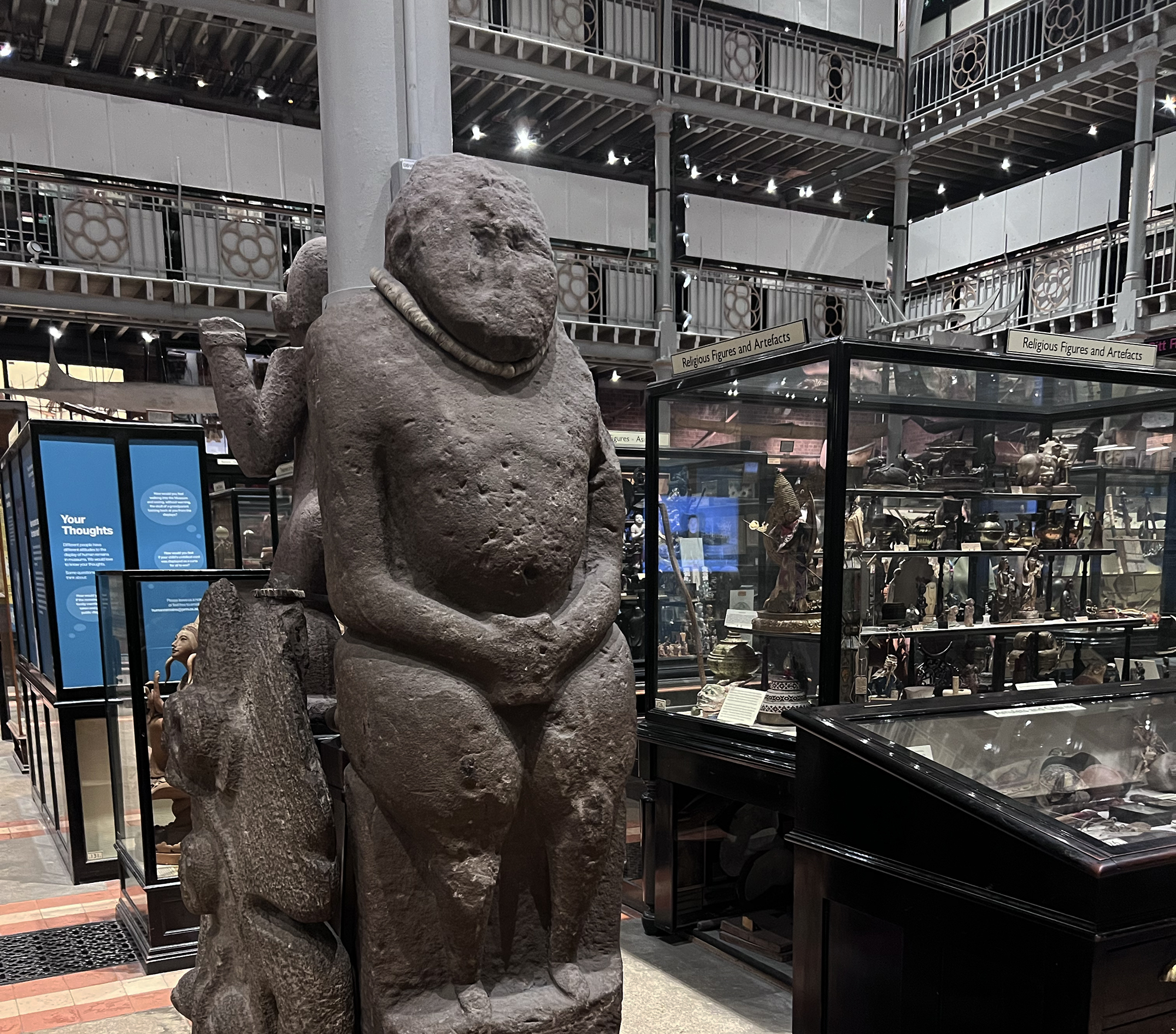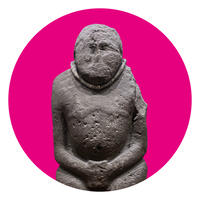Kamyana Baba


Kamyana Baba
Stone figure of a woman, Ukraine
PRM 1890.30.1 Open display
Text by Tsovinar Kuiumchian,
DPhil student in Anthropology, School of Anthropology and Museum Ethnography, University of Oxford
The Kamyana Baba at the Pitt Rivers Museum, created in the early 11th century and collected from its place of origin in the late 19th century, is a fragment of my home. The mysterious presence of the anthropomorphic stone babas colours the memories of my childhood in Dnipro in Eastern Ukraine — a city known as the “land of stone sculptures” that are scattered across the Eurasian continent, from Mongolia to Germany, but are especially common around the territory of my hometown. Facing the central avenue with its boutiques and heavy traffic, the collection of babas outside the Dnipro National History Museum stood on the doorstep of my school. They were immovable and solid, with faintly legible or totally vanished facial features, as though they were guarding with serene introspection something unspoken, unheedful of the bustle of Dnipro’s busiest street. Now, nine years since I left my hometown and six months into the unprovoked war initiated by Russia, I feel more called than ever to listen to the silence of the statues. While the war has indefinitely separated me from the heritage of the Dnipro region, the Kamyana Baba at the Pitt Rivers Museum conjures the magical ecology of the Eurasian Steppe, where I was born, and where cultural currents traversed the vast grassland back and forth for millennia, resulting in an intricate and enigmatic material legacy.
The Kamyana Baba at the Pitt Rivers Museum represents a female figure with absent facial features, a well-defined metal torc around her neck, and a small ritual vessel held by her abdomen, indicating her high-status position in her tribe, as well as her shamanic powers. Her wide hips, reminiscent of Paleolithic Venus figurines, are the quintessential symbol of women as custodians of the very source of life. These qualities were crucial for the makers of the baba, the Cumans, Turkic nomad-warrior people that migrated to Europe from the north-east of the Eurasian Steppe. Deriving from balbal, which means “ancestor” in Turkic languages, these statues functioned as a collective self-portrait and manifestation of the pagan Turkic cult of ancestors, mediating between life and death, the natural and the supernatural. Often erected in the exact place where a Cuman died, babas were sculpted out of stone to contain the soul of the departed, channelling their presence as though they participated in their own burial, thus marking the end of the natural cycle of life. Their statues were honoured with ritual sacrifices and offerings in exchange for ancestral protection of the entire Cuman people. The repeated carving of such statues embodied an attempt to attain safety and prosperity through mastering crucial metaphysical truths. These babas, therefore, were not a passive representation of the Cuman world but a series of experiments with reality and an active engagement with it.
As the Cumans were gradually assimilated and pushed out of the Eurasian Steppe by Eastern Slavs and Mongols, stone babas were severed from their makers. The figure of the stone ancestor with shamanic power was starkly at odds with the worldview of the Russian colonisers, who occupied Ukraine from mid-18th century and saw the shaman as the embodiment of a foreign and dangerous ideology. Many babas and other occult objects were damaged during the occupation by the Russian and Soviet Empires, who persecuted and suppressed all forms of shamanism. Today, although plucked out from their original sites at burial mounds and relocated to various museums, including those of Dnipro and Oxford, the babas still miraculously suffuse their surroundings with their enigmatic presence. Ukrainians’ deep attachment to these statues is a testament to their enduring spiritual power: ‘These babas are our everything’, a visitor of the Dnipro National History Museum once remarked, pointing to the profound emotional pull of the babas on the city’s central avenue, as though they were somehow his own ancestors.
The year 2022 has marked the culmination of an unwavering anti-imperial struggle in Ukraine that aims to restore its particular multicultural fabric, ending the imposed cultural sterility of Russian colonialism that hovers over Ukrainians, as well as Crimean Tatars—the heirs of Cumans, who endured genocide during the Soviet era and annexation of their homeland in 2014. As we encounter the baba in her stony meditation during this moment of crisis and liberation, we cannot but feel that she dreams of the history through which she has endured, its losses and gains, cycles of change, and its hopes of a blossoming future yet to come.
This object featured in the video artwork 'Presence and Absence' by Marina Abramović.
It is one of seven objects you can read about that was part of the exhibition trail on the ground floor of the museum.




